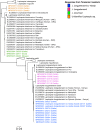Assessment of animal hosts of pathogenic Leptospira in northern Tanzania
- PMID: 29879104
- PMCID: PMC5991636
- DOI: 10.1371/journal.pntd.0006444
Assessment of animal hosts of pathogenic Leptospira in northern Tanzania
Abstract
Leptospirosis is a zoonotic bacterial disease that affects more than one million people worldwide each year. Human infection is acquired through direct or indirect contact with the urine of an infected animal. A wide range of animals including rodents and livestock may shed Leptospira bacteria and act as a source of infection for people. In the Kilimanjaro Region of northern Tanzania, leptospirosis is an important cause of acute febrile illness, yet relatively little is known about animal hosts of Leptospira infection in this area. The roles of rodents and ruminant livestock in the epidemiology of leptospirosis were evaluated through two linked studies. A cross-sectional study of peri-domestic rodents performed in two districts with a high reported incidence of human leptospirosis found no evidence of Leptospira infection among rodent species trapped in and around randomly selected households. In contrast, pathogenic Leptospira infection was detected in 7.08% cattle (n = 452 [5.1-9.8%]), 1.20% goats (n = 167 [0.3-4.3%]) and 1.12% sheep (n = 89 [0.1-60.0%]) sampled in local slaughterhouses. Four Leptospira genotypes were detected in livestock. Two distinct clades of L. borgpetersenii were identified in cattle as well as a clade of novel secY sequences that showed only 95% identity to known Leptospira sequences. Identical L. kirschneri sequences were obtained from qPCR-positive kidney samples from cattle, sheep and goats. These results indicate that ruminant livestock are important hosts of Leptospira in northern Tanzania. Infected livestock may act as a source of Leptospira infection for people. Additional work is needed to understand the role of livestock in the maintenance and transmission of Leptospira infection in this region and to examine linkages between human and livestock infections.
Conflict of interest statement
The authors have declared that no competing interests exist.
Figures



References
-
- Costa F, Hagan JE, Calcagno J, Kane M, Torgerson P, Martinez-Silveira MS, Stein C, Abela-Ridder B, Ko AI. Global morbidity and mortality of leptospirosis: a systematic review. PLoS Negl Trop Dis. 2015;9(9):e0003898 doi: 10.1371/journal.pntd.0003898 - DOI - PMC - PubMed
-
- Abela-Ridder B, Sikkema R, Hartskeerl RA. Estimating the burden of human leptospirosis. Int J Antimicrob Agents. 2010;36(Suppl. 1):S5–S7. - PubMed
-
- Taylor AJ, Paris DH, Newton PN. A systematic review of the mortality from untreated leptospirosis. PLoS Negl Trop Dis. 2015;9(6):e0003866 doi: 10.1371/journal.pntd.0003866 - DOI - PMC - PubMed
-
- Levett PN. Leptospirosis. Clin Microbiol Rev. 2001;14(2):296–326. doi: 10.1128/CMR.14.2.296-326.2001 - DOI - PMC - PubMed
Publication types
MeSH terms
Grants and funding
- R01 TW009237/TW/FIC NIH HHS/United States
- BB/L018845/1/BB_/Biotechnology and Biological Sciences Research Council/United Kingdom
- R01TW009237 /NH/NIH HHS/United States
- BB/J010367/1/BB_/Biotechnology and Biological Sciences Research Council/United Kingdom
- MC_PC_16045/MRC_/Medical Research Council/United Kingdom
LinkOut - more resources
Full Text Sources
Other Literature Sources

